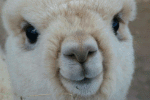Articles by Alpaca World Magazine:
ALPACAS IN THE WESTERN CAPE
Christopher Notley
Things were going from bad to worse in Zimbabwe in 2002 when we came to South Africa on a house hunting trip. Since Alison and I chose to leave Mr Mugabe behind us but not Africa, our area of search was the Western Cape. ?First prize would be an old place to renovate? was what we told estate agents in the hope that we could find something within our budget. So when we were telephoned and invited to inspect a 300 year old farmhouse in the Boland in need of huge renovation we drove from our b&b in Stellenbosch over the Hottentots Holland mountains to Villiersdorp.
What confronted us was indeed a wreck. A sad and badly neglected home. The ?ancient oak trees? in the garden, all two of them, turned out to be so grossly disfigured by age and Cape storms that no tree doctor could ever hope to resurrect them and what remained of the house was squalid to say the least. The garden could at best have been described as ground zero, and rusty and broken barbed wire, adorned with plastic and litter carried in the notorious south-easter winds, outlined the perimeter of the large field in front of the house. The attractions? The 2 ft 6? thick walls of the house, the unusually wide yellow wood ceilings still in beautiful condition but hidden under hideous and tatty ceiling board, a large, sound barn and unbelievably beautiful views of hills and mountains stretching into the distance. All the same, a daunting prospect to tackle, with both of us in our early fifties.
Helderstroom dates back to 1690 when William van der Stel sited a horse camp there. Later, during the period when Lord Charles Somerset was British governor of the Cape between 1814 and 1827, the site served as one of his hunting lodges. We considered ourselves privileged to find a place with English history.
So with heavy hearts, and for all the wrong reasons, we sold Hogerty Hill, our lovely home in Harare where we had lived for many years on five and a half acres ? an ideal sized property for our two horses ? and in December 2002 spent four days on the road towing the horsebox and bringing ourselves plus four cocker spaniels and various cats to our new home in South Africa, to set about a massive renovation job.
It was in early 2003 when my wife Alison was flying to Botswana on business that she picked up a South African Country Life magazine and read an article about breeding alpacas in this country. Helderstroom is more than double the acreage we had in Harare, which begged the question what to do with the extra acres. Alison will say it was her fault we became involved with alpacas because she kept the article and showed it to me on her return and research began on the alpaca project!
Alpacas had already been introduced to South Africa and in October 2004 we acquired five pregnant two-year-old huacaya females, not directly from Chile from whence they originated, but from Gavin Lindhorst, a retired dentist, who had pioneered the importation of alpacas into this country.
And so our first cria was born - a delightful white female, and we were there at the birth. Neither of us said anything to the other as we dried her off and touched her beautiful silky coat. She didn?t look quite like those huacayas in the book, but perhaps that long baby hair would come out, we thought, and the tighter crimp would grow through. It was several weeks later when showing a fellow breeder a photograph of our pride and joy that it was pointed out to us that our first cria was in fact a suri phenotype! Suri, as she was called, has since been sold, at 18 months, to a breeder near Paarl who is concentrating on that phenotype. And at the same time we sold two young males who are now guarding sheep in the Free State.
Our third cria on the ground was a light fawn male. Born with considerable attitude, this animal has good conformation, presence and with his low fibre micron, it is our intention to nurture him as Helderstroom?s first herd sire. His mother, a solid white, then produced a female, equally up to scratch with the qualities of her half-brother. Their individual characters are a delight to study and we have derived huge enjoyment from all of them. They are a source of much amusement and enjoyment to local people who come to view these ?long necked sheep?. We believe that with careful breeding, and good rains permitting, we could sustain up to forty alpacas on Helderstroom?s predominantly kikuyu grass pastures.
It is not unusual for our summer temperatures to reach into the forties and, on rare occasions, such as one day at the end of January this year, 45 degrees centigrade. We are not blessed with natural shade from too many trees but have erected shade shelters under which the animals take refuge in extreme heat. Fortunately a breeze usually accompanies such heat. Still airs in high temperatures are rare.
We are fortunate with first class veterinary assistance in this somewhat remote spot. A small animal vet for the cats and dogs in Worcester, an equine veterinarian in Hermanus takes care of the horses and ten minutes away in Villiersdorp, is Pietie le Roux. Primarily a cattle and sheep man, Pietie attended llamas on a nearby estate which, some years ago, stocked certain exotic animals. His knowledge not only of the camelids but of undesirable flora has been invaluable to us.
As a sideline, Helderstroom?s magic mix of alpaca and horse manure has proved a winner to local gardeners. ?We bag it, you collect it?, we advertise on the notice board of the local farmers? co-op, and they come in their droves!
The alpaca industry is still in its infancy in South Africa and although one or two fashion shows have been held in conjunction with visiting breeders, the general public has still to be educated on the qualities of alpaca fibre. More people are becoming involved in the importation and breeding, both of suris as well as huacayas and some good young stock is being bred. We shear in November which coincides with the onset of the warmer weather. We sold the fibre from our first shearing to a fellow breeder in the area who has a spinning and weaving business, and it is our intention to clean and spin our present fibre ourselves. Alison is convinced we will be able to coerce some of the Afrikaans ladies in the village to take on contract knitting for us. Small beginnings!
Helderstroom Alpacas
Villiersdorp
Western Cape, South Africa
Tweet



